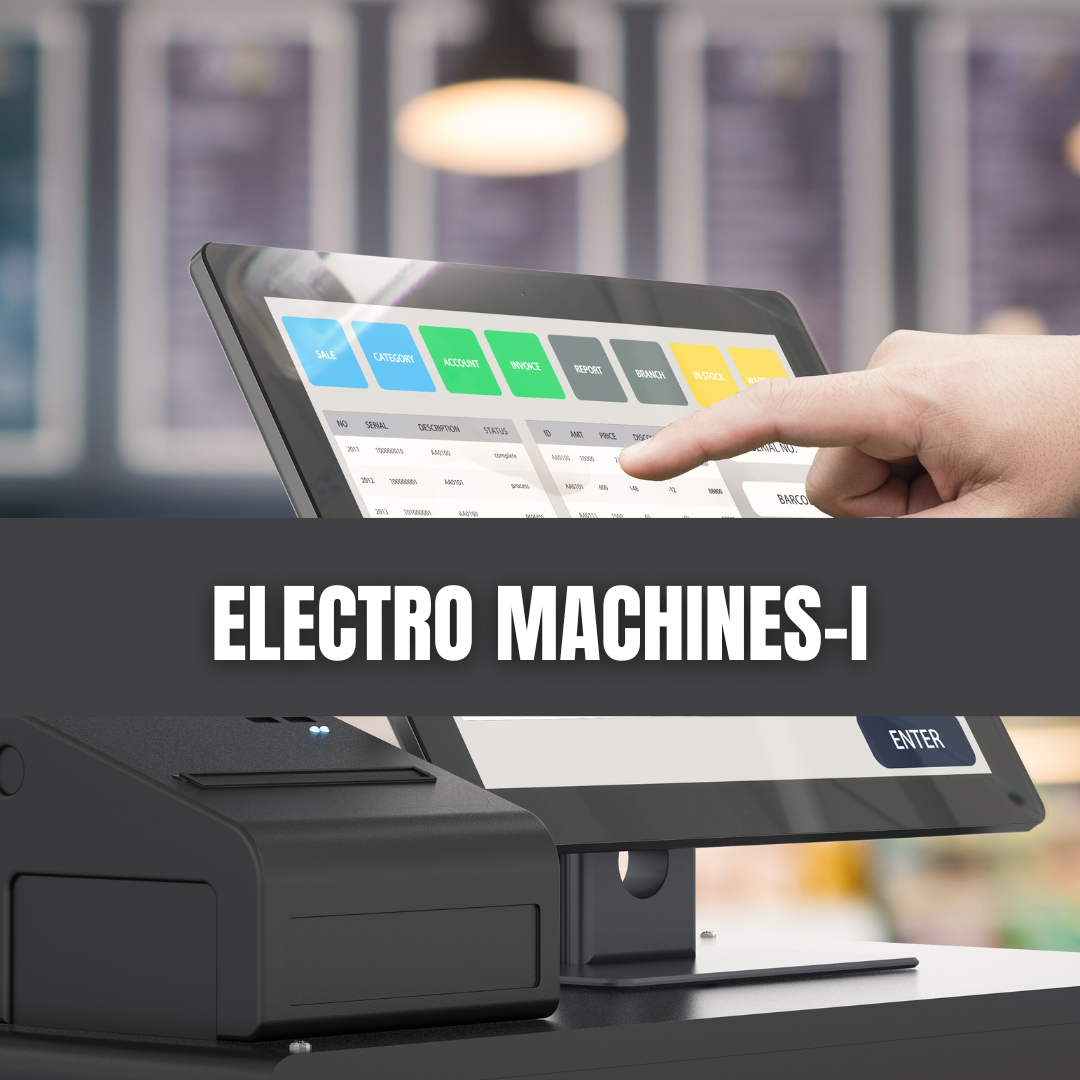Electro Machines-I
₹ 699.00
About the course
Electro Machines-I covers the basic laws governing Electro Magnetic Energy and various terms related to it. We study about Single Phase and Three Phase Transformer in detail after understanding functioning of Ideal Transformer. We also cover DC Motor and DC Generator exhaustively.
What will you learn?
The complete online syllabus of this course comprises 5 Learning Modules | 125 Topics of Learning | 6 Hours of Learning | 41 Assessments
Module
- Introduction to Electro-Mechanical Energy Conversion
- Single Phase Transformer
- Three Phase Transformer
- DC Generator
- DC Motor
Topics of Learning
- Introduction Flow of energy in Electro-Mechanical devices
- Principle of Energy Conversion
- Electric Energy input
- Magnetic Field Energy stored
- Electromagnetic and Reluctance Torques
- Single phase cylindrical rotor Machine
- Two phase cylindrical rotor Synchronous Machine
- Single phase Salient pole Machine
- Electric Field Energy stored
- Dynamic Equations
- Working Principle
- Ratios of Transformer
- Step-up and Step-down Transformers
- Core Type Transformer
- Shell Type Transformer
- Berry Type Transformer
- Comparison Of Core and Shell type Transformer
- Concept of Ideal Transformer
- Transformer on No Load
- Practical Transformer on No Load
- Transformer on Load
- Equivalent Resistance
- Effect of Leakage Reactances
- Equivalent circuits (merge 16 and 17, plus only DDEF/DIA sufficient)
- Approximate Equivalent Circuit
- Approximate Voltage drop in a Transformer
- Voltage Regulation of a Transformer (Merge 19 and 20)
- Core or Iron, Copper, Stray, Dielectric Losses
- Open circuit Test and Short circuit Test
- Back to Back Test
- Polarity Test
- All Day Efficiency
- Construction of Autotransformers
- Copper saving in Autotransformer
- Conversion of two winding Transformer to an Autotransformer
- Advantages, Limitations of Autotransformer and Applications of Autotransformer
- Three-Phase Autotransformers
- Principle of Operation
- Construction of Three phase Transformer
- Bank of Single Phase Transformers
- Three Phase Transformer Groups
- Three Phase Transformer Connections
- Star-Star Connection
- Delta-Delta Connection
- Star-Delta Connection
- Delta-Star Connection
- Open Delta or V-V Connection
- T-T Connection
- Conversion from Three Phase to Two Phase (Scott Connection)
- Reason for parallel operation of Transformers
- Single-Phase Transformers in parallel
- Conditions for parallel operation of Single-Phase Transformer
- Circulating Current
- Three Phase Transformer in Parallel
- Delta connection
- Star connection
- Equivalent circuit of a 3-winding Transformer
- Determination of Parameters of Three-winding Transformers
- Tapping of Transformer
- No-Load Tap changing and On-Load Tap changing
- Instrument Transformers
- Current Transformers
- Potential Transformers
- Transformer Cooling, Rating of the Transformer
- Basic Principle and Construction of DC generator
- Magnetic circuit of a DC machine Armature
- Equivalent circuit of a DC Machine Armature
- Separately excited dc machine
- Shunt wound or shunt machine and Series Wound or Series Machine
- Compound wound or compound machine
- Lap Winding
- Wave Winding, Equalizer Rings and Dummy Coil
- Comparison of Lap and Wave Winding
- Conductor, Turn, Coil and Conductor
- EMF Equation
- Armature Reaction
- Commutation in DC Generators
- Methods of improving Commutation
- Compensating Windings
- Shunt excitation and Series Excitation
- Separately Excited DC Generator
- Voltage Buildup in Self-Excited Generators
- Characteristics of Compound DC Generators
- Reasons and requirements for parallel operation
- Parallel Operation of Shunt Generators
- Parallel Operation of Compound Generators
- Motor principle and its Equivalent circuit
- Direction of rotation and Significance of Back Emf, Voltage Equation
- Torque equation of a DC Motor
- Armature Reaction in a DC Motor and Interlopes
- Characteristics of a shunt or separately excited DC Motor
- Characteristics of a DC series Motor
- Characteristics of a Compound Motor
- Three point DC Shunt Motor Starter
- Four-Point Starter
- Armature resistance control (Rheostatic Control)
- Variation of field flux phase (Field Flux Control)
- Armature Voltage Control (Ward-Leonard method)
- Regenerative Braking
- Dynamic Braking or Rheostatic braking
- Plugging or Reverse current Braking
- Swinburne’s Test (Merge TOLs 20 and 21 and either DEF or DIA required)
- Hopkinson’s Test
- Electrical or Copper losses and Core Losses or Iron losses and other Losses
- Motor applications
- Ratings of Electrical Machines
- Boosters
- Armature Excited or Cross Field Rotating Machines
- Third-Brush Generator
- Three-wire Generator
- Dynamotor and Electric Welding Generator




